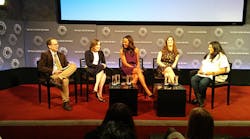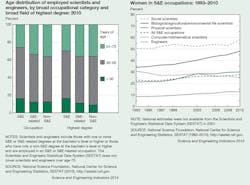Women make up more than 50% of the total population, comprise almost 60% of college students, and are more likely to hold advanced degrees and certifications than their male counterparts--numbers that are clearly not reflected in the field of engineering, or any of the tech fields, for that matter. Fortunately, there are methods with which we can counteract this deficit, and even organizations devoted to it.
In our recent survey, “2014 RF Engineering Salary Survey,” less than 3% of our respondents were women. These results could be skewed somewhat by our readership, but it is an indicator that there may be fewer women in mechanical, electrical, and RF engineering roles than even computer science (12%). If you have worked in this industry, it is obvious that there are very few women working in engineer roles. And, this number has stayed low for decades.
These factors are troubling as U.S. engineers are aging and there are fewer U.S. engineering students and U.S. engineers available in the workforce. The National Science Foundation (NSF) produced a survey, “Science And Engineering Indicators 2014,” which discusses the demographics over time of science and engineering (S&E) fields, which showed an aging population of S&E professionals with less than 18% of members younger than 30 (Fig. 1). Additionally, the NSF survey found that among all S&E occupations, engineering was the least attractive to women (Fig. 2). Though, there might be a slight increase of women choosing engineering-related occupations, this increase may be a product of the increase in foreign students seeking education and jobs within the U.S.
Though not directly discussing “hard” engineering, a recent Paley Center panel discussion, “Cracking the Code: Media Portrayals of Women in Science, Technology, Engineering, and Math,” of actresses and a writer who portray scientists, programmers, and engineers, shared that there might be several significant cultural reason as to why women are discouraged from pursuing science, technology, engineer, and math (STEM) fields. Some of the aspects discussed were that these fields often had an unappealing culture centered around masculine interests, TV and media portrayal of these fields lacking female role-models, and even cultural norms that allow for male children to explore with tools and technology and tend to discourage girls from exploring in the same way.
A recent example of this cultural perspective is Barbie’s recent picture book, I Can Be A Computer Engineer. Though the title seems to be encouraging toward young women taking an interest in computer programming, the book places Barbie’s character more in a facilitatory role in video game design. In the book, Barbie is without the ability to do the actual technical work, and ultimately has to rely on her guy friends to complete the project. This Women in STEM related picture book has received huge backlash online (and has been pulled off the shelves by Mattel), with a viral hashtag (#feministhackerbarbie) supporting thousands of recreations of the book with Barbie actually displaying real technical skill.
Another example of this cultural tendency hits very close to home. My wife is also an electrical engineer by study, and works as an RF engineer. While pursuing our education in the same university, same professors, and same classes, I was strongly encouraged to pursue coursework and research that would put me into deep study of Analog/Mixed-Signal and RF topics. Regardless of my wife’s superior grades and mathematics background, she was never encouraged as strongly or as comprehensively as I was. Not to say that she wasn’t encouraged and that there wasn’t opportunity. On the contrary, we were both provided incredible support and opportunity from our professors and institution. I don’t believe that the lack of intensive encouragement for her was a matter of personality or even intent. I believe it was a matter of unfamiliarity of working with, and motivating, women to reach higher levels of achievement.
My wife has done well for herself academically, now professionally, and continues to encourage and influence young women in personal achievement. As an observer of this process, I have noticed that women are motivated similarly and have much the same interests as men, as far as having fascination for the mechanics of the universe and technological discovery. The main difference I have noticed is that when it relates to tasks that are highly technical and hands-on, down to technically practical tasks like power-tool use, our culture tends to favor encouraging men over women in performing these tasks. For example, if you needed a hand on a project, are you more likely to ask a son or a daughter to grab the drill and get to work?
So how do we help prevent potential technological stagnation due to an underdeveloped participation of women engineers? Just like helping to change societal norms in any other aspect of culture, it requires advocates. We, as engineers, need to advocate to our youth that engineering is both fascinating and rewarding, with special care to treat young women the same. Not special treatment, not pandering, but with the same expectations and encouragement you would promise young men. Women don’t see themselves as “the fairer sex” when absorbed by the complex workings of device physics, they see themselves as problem solvers just as driven as any man to find the optimal solution.
In light of our industries needing more highly technical engineers, we should all consider the effects of us failing to advocate for STEM with our youth. If we don’t promote what fascinates and captivates us about engineering, it is very unlikely that the current college students down to grade-schoolers will have much interest in pursuing STEM fields. And, if we don’t do that fairly, we can’t expect to gain more interest in our fields, which are far out of the public’s eye and interest. So, let a girl play with a wrench and a soldering iron every now and again, would you?




